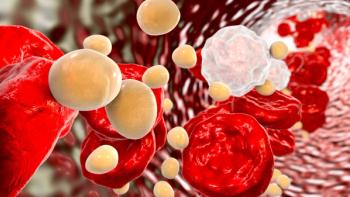
Saturated Fat Content in Breast Tissue Linked to Cancer Risk
Postmenopausal patients with invasive ductal carcinomas had high levels of saturated fats.
Findings from a recent study suggest that breast tissue containing high levels of saturated fats could potentially mean cancer for postmenopausal women.
In a study published in Radiology, researchers used a new technique that helps image fatty acids in breast tissue.
"Our study offers the first evidence--seen in breast tissue--that high saturated fatty acids in the breast adipose tissue is associated with presence of breast cancer in postmenopausal women," said senior author and researcher Sungheon G. Kim, PhD.
Prior studies suggest the risk for breast cancer is associated with body mass index, but researchers in the current study suggest the composition of fatty tissue could be involved in this risk. Researchers used a novel approach called gradient-echo spectroscopic imaging that provides information about types of fatty acids gathered from 3-dimensional MRI images, according to the study.
"There is a clear need for methods that can accurately measure fat composition of the breast tissue within a short scan time, and our study takes a first step towards meeting this critical gap," Dr Kim said.
Researchers included imaging sequences from 89 women considered high-risk patients who were receiving an MRI. There were 58 premenopausal patients and 31 postmenopausal patients included.
After their initial diagnostic MRI, patients then received another scan of 3-dimensional multiple gradient echo sequences. There were 12 patients with ductal carcinoma, 28 with invasive ductal carcinoma, and 49 with benign tissue, according to the study.
Researchers found that postmenopausal patients with invasive ductal carcinoma had breast tissue with higher levels of saturated fatty acids and lower levels of monounsaturated fatty acids compared with begin breast tissue of postmenopausal patients. Researchers said this may suggest that high levels of saturated fatty acids and low levels of monounsaturated fatty acids could be linked to invasive cancer.
Researchers also discovered that postmenopausal patients with benign lesions had high levels of polyunsaturated fatty acids and low levels of saturated fatty acids compared with premenopausal patients. No correlation between body mass index and fatty acids in breast tissue were discovered.
Researchers said the study was limited since it only included a high-risk population, and further research is needed to assess low-risk postmenopausal patients. Researchers added that more work is needed to determine how these fats can influence the development of cancer.
"Measuring breast fat composition only takes an extra five minutes, making this practical, new technique something that could easily be implemented in a clinical setting," said study co-author Linda Moy, MD. "With further research, we could potentially use these findings to change how we look at breast cancer imaging."
Newsletter
Stay informed on drug updates, treatment guidelines, and pharmacy practice trends—subscribe to Pharmacy Times for weekly clinical insights.



















































































































































































































